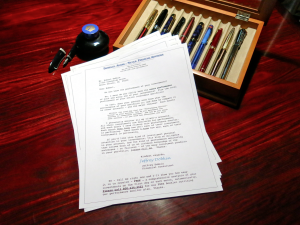Sales Letter Strategy: The Three Letter Campaign
In direct marketing, a letter is the best marketing tool you can use at any price.
OK, wait… giving away a new boat with a purchase is a better marketing tool. So let’s say a letter is the best marketing tool you can use for under a dollar.
Sales Letters can be used at every level:

Letters: Effective marketing Tools
· prospecting letters
· letters that turn prospects into customers
· sales letters that acquire new clients
· letters that protect old accounts
· customer management letter campaigns
· letters that provide great customer support
· letters that build brand loyalty
· letters that promote company loyalty
· letter campaigns that create a higher lifetime value of each customer
· letters that allow you to keep customers for life!
Just ask insurance companies –
you get a letter each year thanking you so much for all the money you spend with them, don’t you?
OK, perhaps I should phrase the question a little differently:
Why do you suppose the insurance companies lose about one third of their clients each year –
is it because they don’t invest the 50¢ to send each customer a thank you letter each year? Yes, that’s a better phrasing.
Letters can be targeted to one person, a broad field, an entire industry, an income group, or defined by geographics, demographics, psychographics, whatever. They can sell, position, generate a call, revive old customers, drive someone into your store or website, invoke just about any kind of response or just make someone feel great about doing business with you. All for just 50¢. Yep. So… why aren’t you sending more of them?
From personal pitches to classless advertisements fraught with misspellings and typographical errors, a letter is a personal portrait of the sender.
A letter is actually the most effective single piece of paper in all of direct marketing.
(Do you know what the most effective single sheet of paper is in all of marketing? It’s a press release. Please see our articles on press releases on this site!)
So, when you send a letter what kind of mark are you leaving in the business world? Is it crusty with jagged edges like my wife, or is it smooth and well researched like my secretary, carefully punctuated with a soft finesse. Does it have voluptuous curves and nice legs like her, too? Of course not… it’s a letter – and every letter has its limitations. Still, it can be most effective for bringing in additional business – even if it doesn’t have silky auburn hair that drifts gently down her forehead when she looks at the computer, and every once in a while you can see her looking at you out of the corner of her eye. I mean, I guess…
How’d you make out with last month’s campaign?
What – you haven’t done it yet? Grrrrr.
I’ll make you a deal. Complete the following letter campaign and if it doesn’t work… I’ll send you a refund of all the money you paid me for it.
Last month we talked about the value of a letter campaign: 3 letters. (It was a short campaign.) You had promised that right after watching Sponge Bob Square Pants you were going to sit down and write 3 letters and send them to your top 100 prospects, and to your top 100 customers. Or, was that my kids promising they’d practice piano…) Anyway, I’ll make you this bet. Craft your letters well, and I’ll bet it brings in business for you. Here’s how.
First, you write your objective. We don’t want to appear too sales-oriented with these letters, so we won’t actually appear to sell anything in the first two letters. Our primary objectives will be to generate a phone call, because all business starts with a phone call. We also want to build a stronger customer relationship, increase customer retention, and build brand and company loyalty. Sales will follow naturally.
Here’s the secret: the best way to meet our objectives is to first thank your current customers for their past business. “Over the past several years I have been happy to serve you.” Nope, sounds like a hooker quitting her job and leaving me a note on my dresser when she, um… I mean leaving her client a note on his dresser. But it’s close.
Never start a letter “Enclosed please find…” Hey, if you’ve included it, they’ve already found it. You don’t ever have to say that in a letter. As a publisher, I send books to a lot of people. It’s pretty superfluous for me to say in my letter, “We have enclosed our book…” No shit, they’d think, as they’re holding our book weighting 2-1/2 pounds. It’s the biggest thing in the box, dwarfing my letter that’s resting on top of it. Whatever you’re sending, I assure you they’ve found it just fine without your mentioning it. Well, at least in the past 20 years I’ve never had anyone call and say, “Geeze, there was a book in the package? Where? We couldn’t find it.”
So what do you say in your first letter?
Even though it’s a sales letter, the main theme is to say “Thank you!”
”Thank you so much for your business. I appreciate it. There are hundreds of firms where you can purchase goods and services similar to ours, but you buy them from us. Please accept my many thanks, I really appreciate your business and your trust.” Get the idea?
The second letter mentions the previous letter (to make sure they didn’t forget it), and make sure they remember if was YOU who sent it: “In my last letter to you, I’ve tried to express just how much I appreciate the business you award to our firm.”
Then briefly show some benefits of doing business with your firm: “I’m not sure I mentioned it, but there are some things you receive with our firm you won’t find in any of our brochures.” A key phrase of exactly why you’re writing this new letter. Let them know that along with your very personal service, they get your guarantee of complete satisfaction with every product they purchase from you. “If you’re not happy, we’re not happy – and I encourage you to call me directly with any problems or questions so I can resolve any issues to your immediate and complete satisfaction.”
Painting a picture of a firm everyone wants to do business with is easy in a letter. But like any promise, it’s much easier to make than to keep – so you have a fresh chance to show them you mean it: Ask them to call. Every call you receive is an opportunity for you to increase the value you provide. Please read that line again so I don’t have to type it twice. Yes, it’s that important.
The third letter again entices the customer with benefits, then at the end encourages the reader to call with the soft sell of, “We’re here for you all day, every day. Please call me at any time to place an order, with questions, or with your comments about our products or services. I’m always as close as your phone. If you need me after hours, here’s my personal cell phone number:” It’s OK to turn your phone off after work but if you really want to provide that extra margin of service, get an after hours business cell phone, or leave your personal cell phone turned on.
In the close of the third letter you can present a harder sell for the phone call if you like.
Article Summary – The strategic use of letters: 1. when you want to attract a new client to call you, 2. to keep a client, 3. to provide a highly visible way to show your level of service is excellent, 4. to stay in top-of-mind awareness so when a client needs your products or services – or needs to recommend a firms products and services to a colleague – they will think of you first. And 5. to provide a highly personal level of service.

Jeffrey Dobkin
Bio –
Jeffrey Dobkin is a specialist in direct response marketing. Specialities include copywriting, sales letters, TV commercials and scripts; persuasive catalog copy; website copy and content, and exceptionally response-driven direct mail packages. He also analyzes direct marketing packages, ads, catalogs, websites and campaigns. Mr. Dobkin is a pretty funny speaker and a direct marketing consultant. Call him directly at 610-642-1000 to discuss your marketing needs or for free samples of his work. Ask him for a free copy of one of his books – you deserve it for reading this far. Thanks for reading this article.
Where would you like to go now? Direct Marketing Articles List.
Our most popular article on writing letters.
Learn about Press Releases. Read some really offensive Funny Articles.
See our FREE Sample insurance sales letter. Or simply go home and start again…